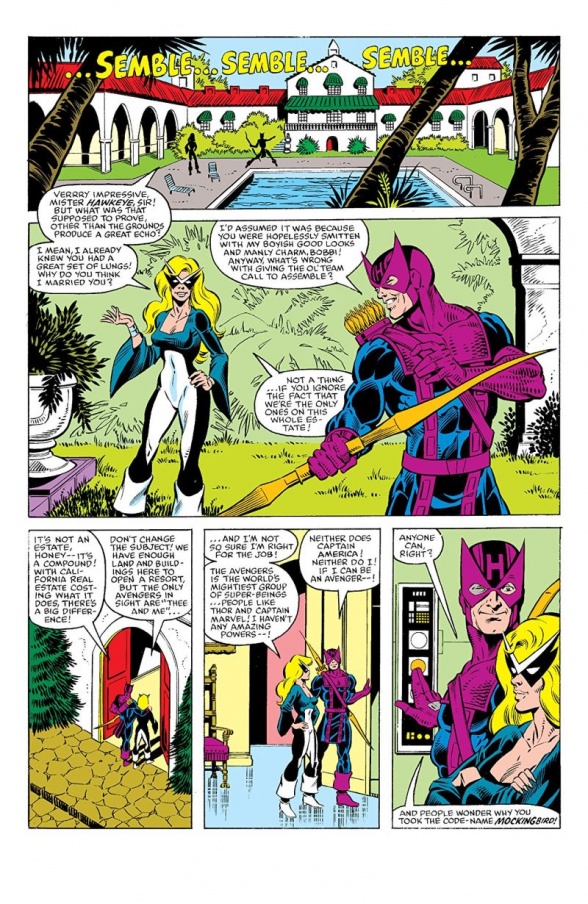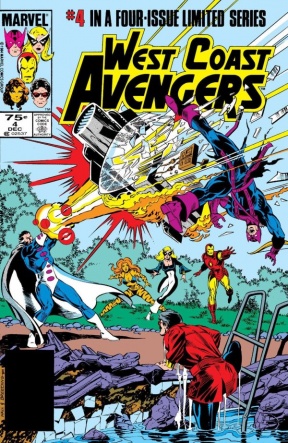
Welcome to Avengers Historian, your monthly look at Earth’s Mightiest Heroes, and their past adventures. The aim of this column is to examine the history of Avengers comics: both the fictional biography of the superhero team, and also the work of the creators who bring them to life. By picking through a few decades worth of back issues and bits of trivia archived in forgotten corners of the internet – I hope to shed light on the stories, characters, and ideas that have been examined through the adventures of earth’s mightiest heroes.
The focus of this first Avengers Historian column will be on the 1984 “West Coast Avengers” four-issue miniseries written by Roger Stern with pencils by Bob Hall and inks by Brett Breeding, with colors by Julianna Ferriter on #1-3 and Ken Feduniewicz on #4. Joe Rosen did the letters on #1 and #4, Diana Albers did them on #2 and Rick Parker lettered #3.

Former mayor of Los Angeles Tom Bradley once said that “People cut themselves off from their ties of the old life when they come to Los Angeles. They are looking for a place where they can be free, where they can do things they couldn’t do anywhere else.” The founding members of the West Coast Avengers consist of a failed Hollywood actor who is no longer really human; a Navy veteran pretending to be a founding Avenger; an ex-spy; an orphaned carnival-attraction; and a cat-woman who feels like she’s never had control over her life. This is certainly a group of people who have an interest in moving on to the next stage of their lives.
The idea for this expansion team was introduced in the pages of the main “Avengers” title because the Vision wanted to have a wide roster of Avengers ready to spring into action all across the country. This expanded active roster was secretly a part of his malfunctioning desire to take over the world.

The real-world origins of the “West Coast Avengers” title have a similar theme of control (albeit of a markedly less sinister nature). Roger Stern and Mark Gruenwald came up with the idea for the team at a comic book convention. Stern was having problems using the Avengers he wanted because they were being used by many different writers across many different titles. “‘The West Coast Avengers’ was my solution to that,” Stern said in an interview with George Khoury that can be found on the Marvel Masterworks Resource Page. “The original plan was to establish a second branch of the team in California. And once the miniseries was over, I’d have the members of both branches to draw on for stories.”
But the miniseries was too successful, it actually outsold the main “Avengers” book. So instead of establishing a team that could exist as guests in his “Avengers” title, Stern created a team so popular that when Steve Englehart returned to Marvel, he was given an ongoing “West Coast Avengers” book without Stern getting so much as right of first refusal. This had major plot ramifications according to Stern in his interview with Khoury, “I went from having all of these characters lined up to completely losing control of half of them. I had to scrap plans for at least a year’s worth of stories. It took me months to get caught back up.”
In “Marvel Age” #29, Englehart was interviewed by a young Kurt Busiek. Based on that interview, it’s clear that Englehart certainly had a different view of how intertwined the books should have been, “Well, I don’t think they’re going to connect too much. I see Roger and myself as doing two different foci of the umbrella group, ‘the Avengers,’ but I don’t know how much back-and-forth there’s going to be. For one thing, Roger tends to work months in advance – I think Roger knows what he’s going to do for the next year – and as you may have gathered, I sort of go from month to month.” These were creators on different wavelengths. But even before this split, the Stern-written miniseries set itself apart from the longstanding east coast team.
Continued belowPalm trees and pools populate the very first panels of “West Coast Avengers.” This is quite a shift from the gated old mansion of the original team. This visual aesthetic is expertly maintained throughout the series by the art team. Julianna Ferriter and Ken Feduniewicz fill these issues with lovely pastels, the backgrounds of panels in particular are frequently filled with sunny shades of green, blue, yellow, and pink. The red costumes of Iron Man and Wonder Man, the deep orange of Tigra’s fur, and the rich purple of Hawkeye’s costume pop dramatically in front of these lighter tones. By using tropical hues as the default, the darker moments of action in the series easily signal shifts in dramatic gravity (when a gas station explodes in issue #2, when Tigra tries to stay afloat on the open ocean in issue #4, or whenever the Shroud appears). It’s fascinating to study how series penciller Bob Hall manages the gaps between those darker moments of action. He has the challenge of making sure that Stern’s many pages of dialogue stay visually compelling. He expertly keeps his many-paneled pages from feeling claustrophobic by framing the characters with plenty of white space and plenty of room to breathe. This visual freedom is further assisted by the perpetually clean lines provided by inker Brett Breeding.
While the founding Avengers were brought together by a god of lies and tricks, these spinoff Avengers don’t need a god, they generate their own facades and disguises. Jim Rhodes joins the team as a rookie Iron Man, not immediately correcting his teammates’ assumption that he’s the same man who has been fighting in the armor for year. Hawkeye repeatedly overthinks his role as leader – he postures and grandstands while filling thought bubbles and private conversations with doubts. Tigra oscillates between flirting confidently and doubting if she belongs at all. Wonder Man wears sunglasses to cover the inhuman red glowing that has replaced his eyes. These are a bunch of pretenders who wish for the life of legitimate heroes.

Ironically, their pursuit of heroism fails when sought through traditional means. California’s mightiest heroes only save the day when they resort to backhanded tactics. An attempt to defend their superhero stronghold results in a sloppy and unnecessary battle with the friendly Shroud. An attempt to stop a bank robbery only results in a broken window and an escaped villain. However, when the team crashes a sleazy party in Santa Monica – when they fully embrace the artifice, the lies, the superficiality – then the day is saved. Mockingbird pretends to be bartender while feeding the guests toxic cocktails. Tigra pretends to be a scantily-clad Madame Masque and seduces the supervillain Graviton. Hawkeye is a pretend hitman (complete with mustache and white suit). This isn’t a plan Captain America would have thought up but at the end of the miniseries, the West Coast Avengers have proven themselves to be true Avengers.
There is a psychological phenomenon known as Imposter Syndrome. It’s the feeling when, after getting hired for a fancy new job or being recognized for an award, you suspect that you’ve pulled a fast one on everyone. It’s the feeling that you’re a fraud, that you’ve been faking it, and that inexplicably no one has noticed. The West Coast Avengers are basically the Imposter Syndrome Avengers and it’s wonderful and reassuring to watch literal superheroes struggle with such relatable doubts.

Bonus Fact:
“‘West Coast Avengers,’ by the way, was just supposed to be a placeholder name. But we were never able to think of a better title. Sorry about that.” – Roger Stern (quote his interview with Michael Khoury in “Back Issue” #56)
Quotes and facts for this article were drawn from the following sources:
• Michael Aushenker, “Avenging the Left Coast,” Back Issue, #56, 2012.
• George Khoury, “The Roger Stern Interview: The Triumphs and Trials of the Writer.” Marvel Masterworks Resource Page (http://www.marvelessentials.com/features/int_stern_1006_1.html)
• Kurt Busiek, “The Marvel Age Interview: Steve Englehart,” Marvel Age, #29, 1985.






